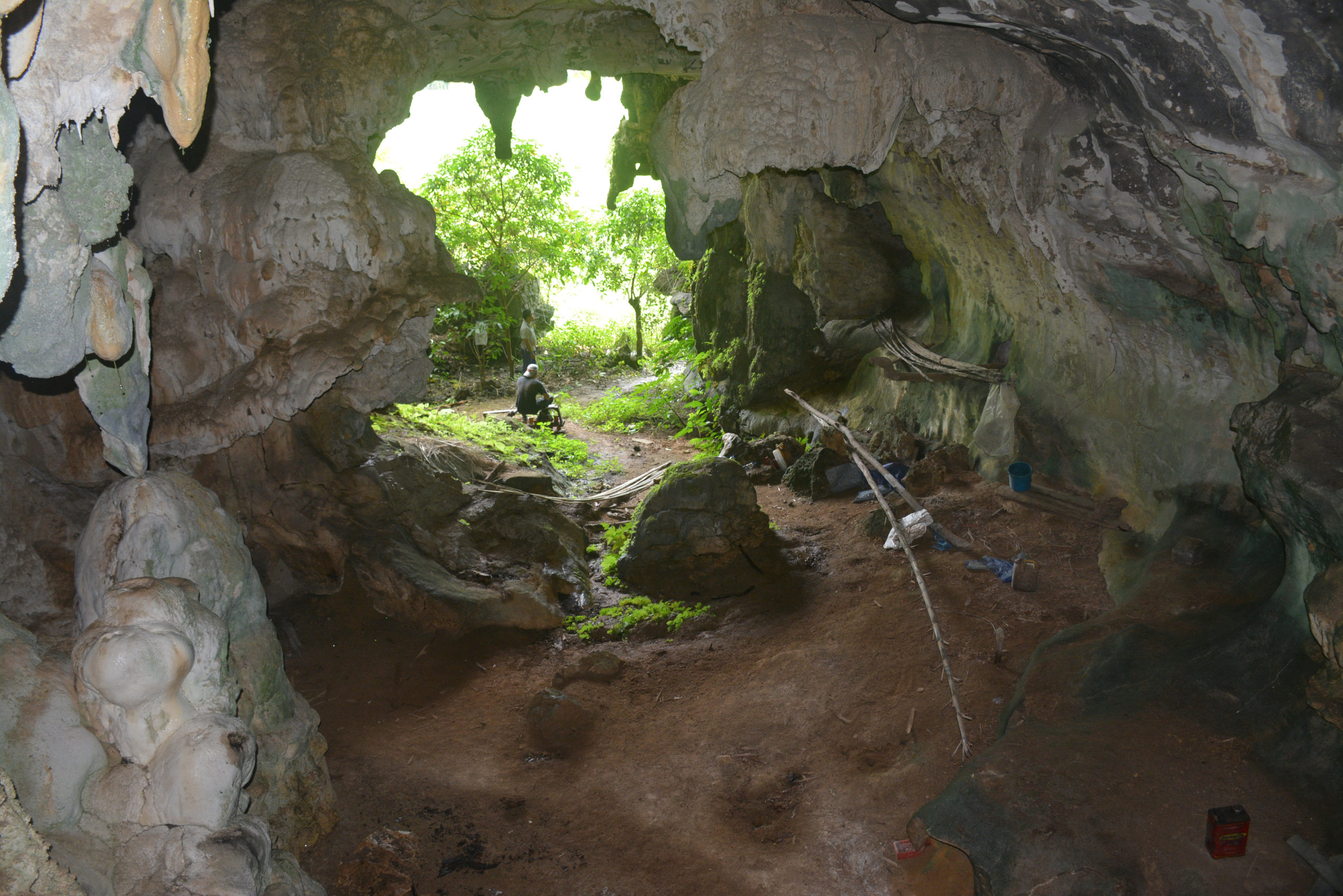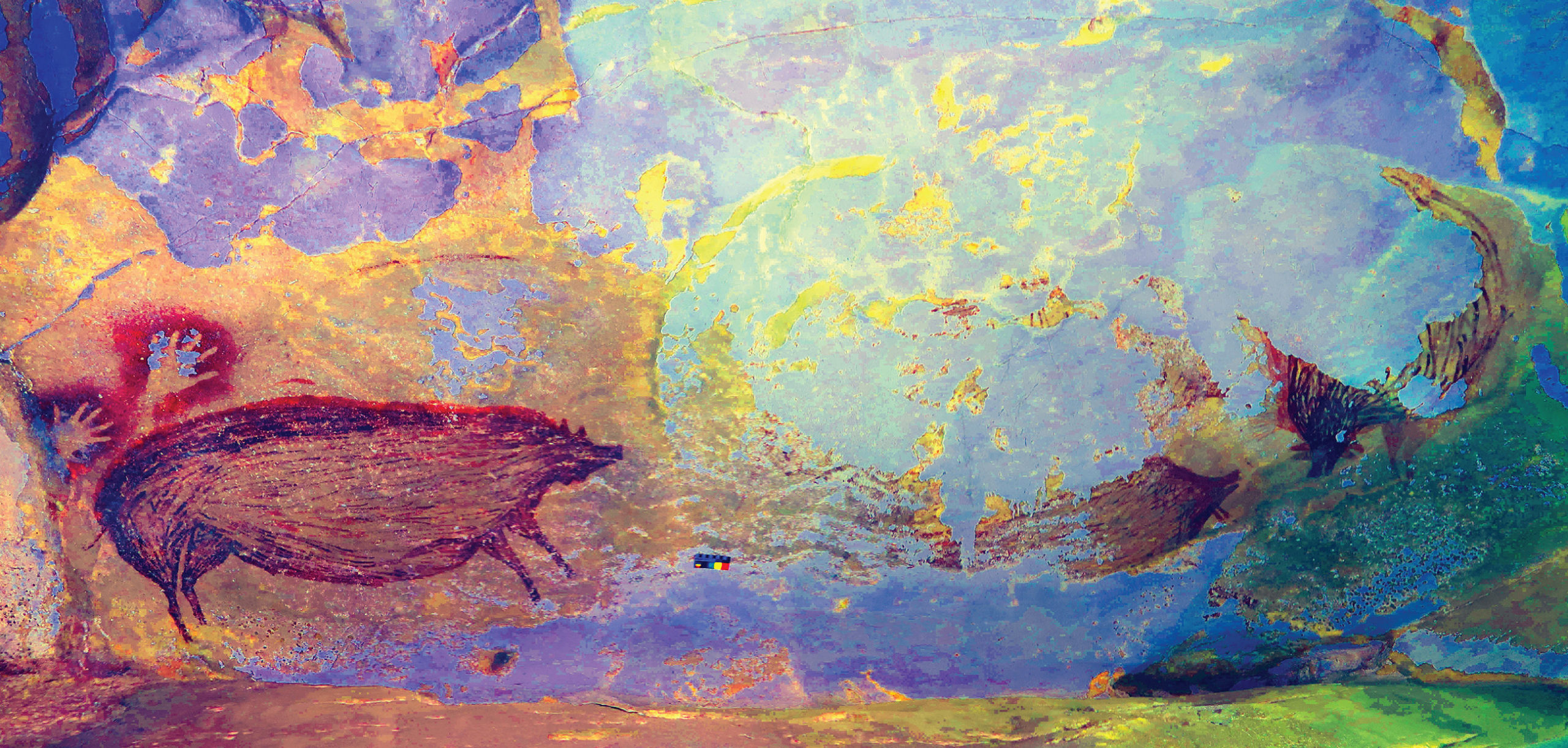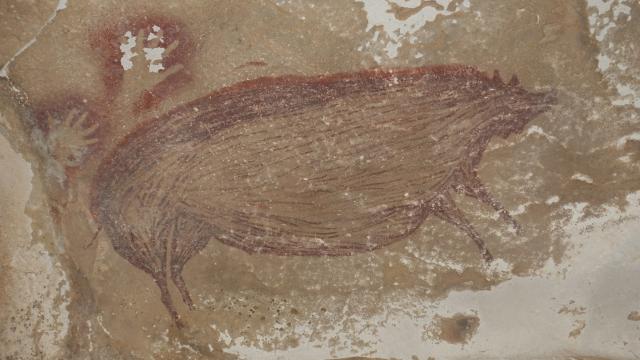A pig painting inside an Indonesian cave has been dated to 43,900 years old, making it among the oldest — if not the oldest — known figurative art piece in the archaeological record.
The painting was found at the Leang Tedongnge cave site on Indonesia’s Sulawesi island. The artwork appears to depict a confrontation or some sort of social interaction, between three Sulawesi warty pigs (Sus celebensis). These short-legged pigs, with their characteristic warty faces, are still around today, and during the Pleistocene they represented an important prey animal for the early humans who lived in this part of the world. That early humans living on the island would depict these creatures on their cave walls is an indication of their cultural, social, and existential importance.
The team responsible for the discovery, led by Adam Brumm and Maxime Aubert from Griffith University in Brisbane, Australia, also found a pig painting at the nearby Leang Balangajia site, which was dated to 32,000 years old A new paper describing these findings is published today in Science Advances.

“This is significant not only because these paintings are some of the oldest known ages for figurative artwork from anywhere in the world, but because this art represents the earliest evidence of anatomically modern humans in Sulawesi,” Kira Westaway, an associate professor from the Department of Earth and Environmental Sciences at Macquarie University in Australia who wasn’t involved with the study, explained in an email.
Indonesia has some of the world’s oldest cave paintings. On Sulawesi island, archaeologists have documented around 300 caves and rock shelters with cave art, including depictions of animals and hand stencils. Earlier at the Leang Bulu’ Sipong 4 cave site (which is located in the same karst area), this team discovered the oldest known depiction of a hunting scene, in which human-like figures pursued warty pigs and buffaloes, which was dated to 43,900 years old.
As for the animal painting at Leang Tedongnge, the authors say it is, to their knowledge, the “earliest known representational work of art in the world.”
But it might not be.
Cave paintings of animals, as well as dots, geometric shapes, and hand stencils, have been found in Spanish caves, likely drawn by Neanderthals, which date back some 64,000 years. Other considerations include a 73,000-year-old cross-hatched pattern found in South Africa and a 75,000-year old Neanderthal stone-bone figure, called the Mask of La Roche-Cotard, which is arguably an example of figurative, or representational, art.
The authors do make mention of the Neanderthal cave art, claiming that it’s “nonfigurative rock art” (everyone’s a critic) and that the “empirical evidence used to support this proposition, dating and otherwise, has been vigorously contested.” Other archeologists will be inclined to disagree.
At the very least, the artwork from Leang Tedongnge is now the oldest dated cave painting in Sulawesi and the oldest evidence of anatomically modern humans on the island, and possibly even the wider Wallacean region, according to the new paper.
The painting at Leang Tedongnge depicts at least three pigs, one of which is large and well-defined, while the others are incomplete. The large pig measures 136cm long and 54cm high. The authors say the artwork could be depicting a narrative scene, in which the pigs are confronting each other. At the Leang Balangajia cave, the large red pig measures 187cm tall and 110cm high and is accompanied by at least two other animal motifs. Both sites also feature imprints of human hands stenciled onto the cave wall.

To find the age of the paintings, the scientists performed uranium-series isotope dating of mineral deposits found on the cave walls. These mineral deposits, which look like puffs of popcorn stuck to the wall, make the dating of artworks possible, providing a minimum age. The mineral deposits could have formed long after the paintings were drawn, so the art might actually be older.
Typically, archaeologists use stone tools and fossils to place early humans at a specific geographical and temporal location, but in this case, cave paintings have taken on this role. Indonesia, said Westaway “is the only country in which art is its oldest evidence.”
“This is mainly because the art, usually incredibly challenging to date, has been painted on limestone rather than sandstone as seen [elsewhere], so it’s inherently datable,” she explained. “Limestone enables the precipitation of speleothems [mineral deposits] which can be very reliably dated using [uranium-series] dating techniques. As the art can so readily be constrained, this increases its significance and places a huge emphasis on building up a large body of evidence for the art in the region in lieu of other older evidence.”
The authors can’t be 100% certain that early modern humans created these artworks, but they say it’s the most likely explanation, given the “sophistication of this early representational artwork and the fact that figurative depiction has so far only been attributed to [anatomically modern humans] everywhere else in the world.” An unlikely possibility is that the drawings were made by Homo erectus, a species that died out in the region, specifically Java, between 117,000 and 108,000 years ago.
Chris Stringer, a physical anthropologist from the Natural History Museum in London who wasn’t involved with the new research, said the authors did a “pretty good job” in providing minimum ages for these cave paintings.
“This research pushes back the date of the earliest figurative art in Sulawesi, and as the authors argue by extension, globally,” explained Stringer in an email. “I think it’s increasingly likely that the modern humans who were beginning to emerge from Africa about 60,000 years ago were already producing figurative art, and we simply haven’t found the evidence yet.”
Westaway said early humans typically painted what they saw every day and that the depictions of warty pigs indicate the importance of these animals to their culture and well-being.
“This research,” in combination with the previous studies from this same team, “greatly contributes to our understanding of modern humans in this region, their abilities as artists — a typical modern trait — but also insights into their behaviours, lifestyles, and what they valued,” said Westaway.
